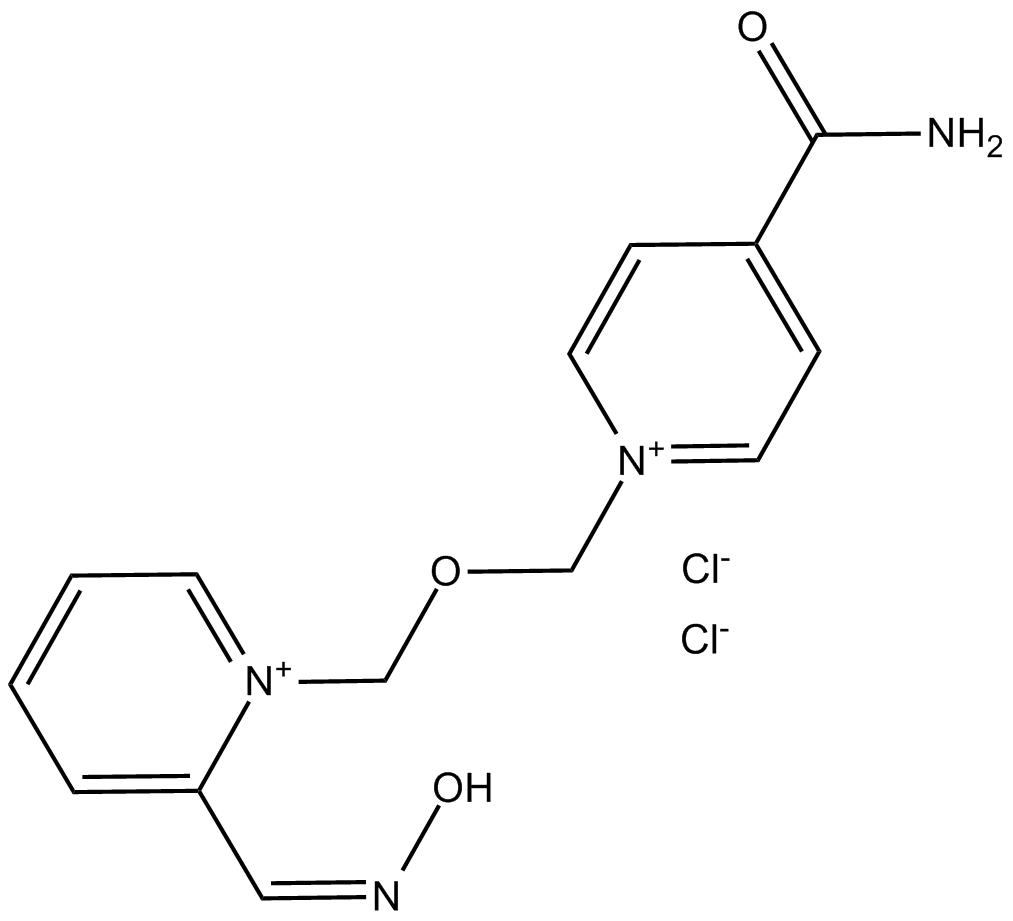Asoxime (chloride) (Synonyms: HI-6) |
| Catalog No.GC15438 |
Asoxime (chloride) (HI-6) is an antagonist to acetylcholine receptors (AChRs) including the nicotinic receptor, α7 nAChR.
Products are for research use only. Not for human use. We do not sell to patients.

Cas No.: 34433-31-3
Sample solution is provided at 25 µL, 10mM.
IC50: 8.9 μM: blocks AChE in human; 126 μM: inhibits acetylcholinesterase (AChE) in bovine; 160 μM: blocks muscarinic acetylcholine receptor M1, M2, M3 and M4 in mouse.
Asoxime, also known as HI-6, is an asymmetric bis-pyridinium aldoxime and reactivates AChE via nucleophilic attack of oximate anions on organophosphate-AChE conjugates.
AChE, one of the primary targets of organophosphates, is inactivated by organophosphates via reacting covalently with the active center serine, which blocks the hydrolyzation of acetylcholine at peripheral and central synapses. Additionally, the accumulation of acetylcholine leads to an over-stimulation of cholinergic receptors, which disrupts a variety of biological functions.
In vitro: HI-6 showed a bacteriostatic effect on Francisella tularensis (F. tularensis) and inhibited the growth of F. tularensis when treated with 100 mM HI-6 [1].
In vivo: Female BALB/c mice, infected by F. tularensis, were administrated subcutaneously with 100 μl HI-6 for ten days. The lower dose of HI-6 yielded in different symptoms and mortality. Compared to mice injected only with tularemia, groups of mice exposed to the lower dose of HI-6 showed a decline in mortality, which can be explained via higher efficacy of bacteriostatic effect while the toxic effect was decreased [1]. Female Wistar rats were treated intramuscularly with HI-6 at a dose of 15.6 or 156 mg/kg for one day. The level of thiobarbituric acid reactive substances was increased, which was triggered by HI-62 [2].
References:
[1]. Pohanka, M., Pavli, O., Pikula, J., Treml, F., & Kuca, K. Modulation of Tularemia Disease Progress by the Bisquaternary Pyridinium Oxime HI-6. Acta Veterinaria Brno. 2010; 79(3): 443-448.
[2]. Pohanka, M., Sobotka, J., Svobodova, H., & Stetina, R. Sulfur mustard induced oxidative stress and its alteration using asoxime (HI-6). Interdisciplinary Toxicology. 2013; 6(4).
| Cas No. | 34433-31-3 | SDF | |
| Synonyms | HI-6 | ||
| Chemical Name | 1-[[[4-(aminocarbonyl)pyridinio]methoxy]methyl]-2-[(hydroxyimino)methyl]-pyridinium, dichloride | ||
| Canonical SMILES | O/N=C\C1=CC=CC=[N+]1COC[N+]2=CC=C(C(N)=O)C=C2.[Cl-].[Cl-] | ||
| Formula | C14H16N4O3 • 2Cl | M.Wt | 359.2 |
| Solubility | ≤10mg/ml in PBS(pH7.2) | Storage | Store at -20°C |
| General tips | Please select the appropriate solvent to prepare the stock solution according to the
solubility of the product in different solvents; once the solution is prepared, please store it in
separate packages to avoid product failure caused by repeated freezing and thawing.Storage method
and period of the stock solution: When stored at -80°C, please use it within 6 months; when stored
at -20°C, please use it within 1 month. To increase solubility, heat the tube to 37°C and then oscillate in an ultrasonic bath for some time. |
||
| Shipping Condition | Evaluation sample solution: shipped with blue ice. All other sizes available: with RT, or with Blue Ice upon request. | ||
| Prepare stock solution | |||

|
1 mg | 5 mg | 10 mg |
| 1 mM | 2.784 mL | 13.9198 mL | 27.8396 mL |
| 5 mM | 0.5568 mL | 2.784 mL | 5.5679 mL |
| 10 mM | 0.2784 mL | 1.392 mL | 2.784 mL |
Step 1: Enter information below (Recommended: An additional animal making an allowance for loss during the experiment)
 g
g
 μL
μL

Step 2: Enter the in vivo formulation (This is only the calculator, not formulation. Please contact us first if there is no in vivo formulation at the solubility Section.)
Calculation results:
Working concentration: mg/ml;
Method for preparing DMSO master liquid: mg drug pre-dissolved in μL DMSO ( Master liquid concentration mg/mL, Please contact us first if the concentration exceeds the DMSO solubility of the batch of drug. )
Method for preparing in vivo formulation: Take μL DMSO master liquid, next addμL PEG300, mix and clarify, next addμL Tween 80, mix and clarify, next add μL ddH2O, mix and clarify.
Method for preparing in vivo formulation: Take μL DMSO master liquid, next add μL Corn oil, mix and clarify.
Note: 1. Please make sure the liquid is clear before adding the next solvent.
2. Be sure to add the solvent(s) in order. You must ensure that the solution obtained, in the previous addition, is a clear solution before proceeding to add the next solvent. Physical methods such as vortex, ultrasound or hot water bath can be used to aid dissolving.
3. All of the above co-solvents are available for purchase on the GlpBio website.
Quality Control & SDS
- View current batch:
- Purity: >98.00%
- COA (Certificate Of Analysis)
- SDS (Safety Data Sheet)
- Datasheet
Average Rating: 5 (Based on Reviews and 23 reference(s) in Google Scholar.)
GLPBIO products are for RESEARCH USE ONLY. Please make sure your review or question is research based.
Required fields are marked with *



















